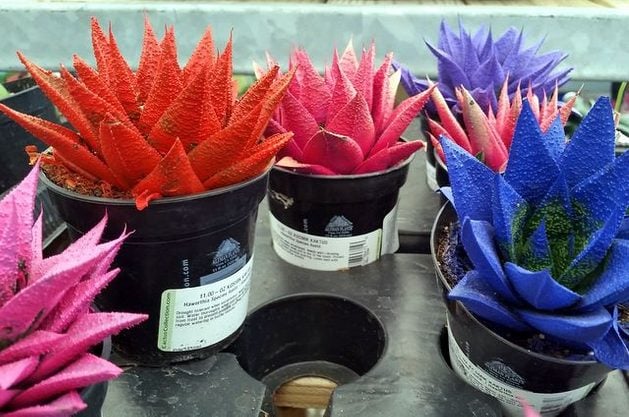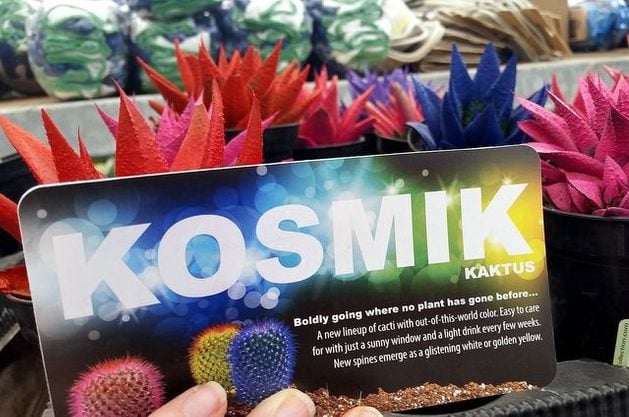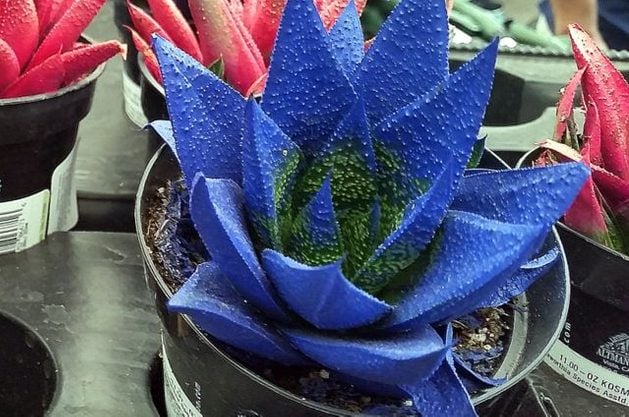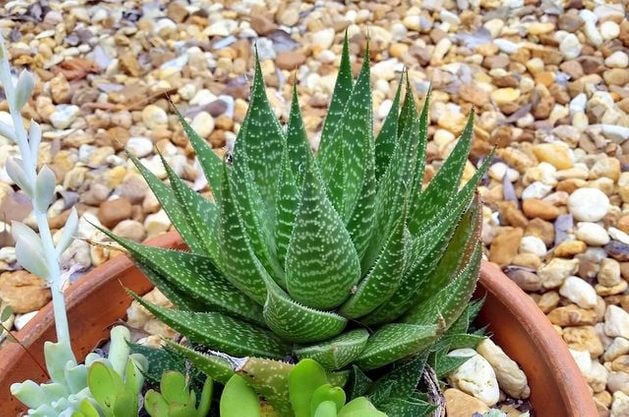Let’s Talk About Painted Succulents
Updated: Apr. 24, 2020
The bright colors will catch your eye, but what are you really getting when you buy painted succulents?
Let me start by saying I’m not here to judge. If painted succulents really excite you, that’s OK by me. But I’d be less than honest if I didn’t admit up front that these flashy flora are really not my thing. Today I’m sharing some of my concerns with you, and a word or two of caution. If you run out after reading this and buy a potful of painted succulents, at least you’ll do it knowing exactly what you’re getting.

Over the last couple of years, these displays of colorful plants have caught my eye at the nurseries of several big box stores. Sometimes by the registers, sometimes with other succulents, their vivid hues are designed to make you stop and look twice. So I did. Frankly, I was pretty appalled at what I found, because it seemed to me that these plants were being marketed in a somewhat disingenuous fashion.

“Kosmik Kaktus,” shouts the label. “A new lineup of cacti with out-of-this-world color.” We’ll get to the “kaktus” part in moment, but let’s start with “a new line-up.” In the plant world, new varieties of plants involve a lot of work on the back end by horticulturalists. They cross-breed and hybridize, seeking out special characteristics that gardeners may enjoy in their gardens. Their work is highly scientific and takes massive dedication. Folks have been doing this work for centuries, creating everything from the corn we love to eat on the cob to hundreds of varieties of roses that fill our garden.
The “new lineup” touted here has undergone none of that intensive study and labor. Instead, these plants are colored using a dye (said to be food-safe and non-toxic by the company, which seems to be part of Altman Plants). On close inspection, it appears the plants are either sprayed or dipped into this paint. The color, of course, is on the surface of the plant only. It will probably wear off over time, and newly emerged parts of the plant will certainly not show these unnatural hues.

Now, succulents are indeed slow growers. These painted succulents may show color for months or even years, if they survive that long. I can’t speak to how this color alteration may affect their photosynthesis. Succulents undergo photosynthesis a little differently from other plants, but they do still need it. It’s possible this dye has no effect, but I certainly can’t state that for sure. It seems more likely to me that most folks who buy these plants do it for the novelty factor, and wind up leaving it on a windowsill to be forgotten and slowly die. (Again – no judgement. I’ve killed plenty of plants by neglect in my day.)
A note about “kaktus” – savvy gardners will note that the plants shown here not cacti at all, but a different type of succulent known as haworthia. The Kosmik Kaktus tag indicates that the company also offers actual cactus in these eye-catching shades, but it’s worth noting that cactus and haworthia have different care needs. If you do purchase one, look closely at the label on the of the plant to determine its type and requirements for care.
As for me, I find succulents on their own to be plenty fascinating, without the need to dress them up. Below is a haworthia I’ve been growing for about six months in my own garden. I think it’s much more interesting in its natural color and pattern. What’s more, there are many more colorful succulents already provided by nature – blues and greens, reds and pinks. I’d rather collect and grow those any day.

But that’s just me. I’m never going to be one for painted succulents. If you love the concept, you should be able to find these at your local big box nursery, or you can even try making one yourself using water-based paints. Just remember that the plant underneath still needs proper care.




















